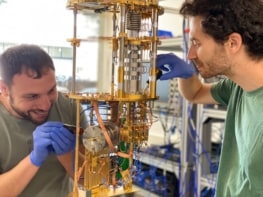
A new device that converts laser light into mechanical work could be used to manipulate nano-scale objects for applications in nanofluidics and particle sorting. The device, which is based on a self-assembled hexagonal array of nanoparticles that operates like a gear, can perform work in conventional environments such as room temperature liquids, according to Norbert Scherer of the University of Chicago, who led the research effort to develop it.
The “gear” in this study is made up of optical matter (OM) – a type of material in which metal nanoparticles are held together by light rather than the chemical bonds that unite atoms in ordinary matter. The radii of the nanoparticles are much smaller than the wavelength of the light, and the light-based “bonds” that link them stem from inter-particle interactions that cause them to self-assemble into ordered arrays (see image above).
SAM and OAM
Finding a way to make these optically-powered self-assembling nanomachines perform work has been a long-standing goal in this area of photonics. The new OM machine achieves this objective by converting spin angular momentum (SAM) – one of the two independent components of the angular momentum of light – into the other component, orbital angular momentum (OAM).
SAM is a familiar property of light that manifests itself as polarization. It arises when the electric and magnetic field vectors of light rotate over the course of a wavelength. OAM is less well known (it was only discovered in 1992), and its effect is to twist a beam’s wavefront along its propagation axis so that it takes on a spiral shape, with zero intensity at its centre. A beam can, in principle, twist by any amount; the greater the twist, the faster the rotation of the wavefront.
OAM suitable for a wider range of applications
Because SAM can have only two values – right or left circular polarization – its applications are fairly limited. In contrast, OAM, which results from the rotation of a light wave’s phases, can take on any value. This variability makes it suitable for a wider range of applications, including “optical spanners” – devices that trap and rotate tiny particles using light. Transferring data though optical fibres without crosstalk (multiplexing) is another potential application.
In their previous work, Scherer and colleagues discovered that when they applied circularly-polarized light to optical matter, the nanoparticles rotated like a rigid body in a direction opposite to the rotation of the polarization. Simply put, this means that when the incident light rotates one way, the optical matter array spins in the other. The researchers hypothesised that they could develop a machine based on this “negative torque”, as it is called.
OM machine functions like a mechanical machine
In the new experiments, which are described in Optica, the researchers set out to create an OM machine that functions like a pair of interlocking gears. When the larger gear is turned, a smaller interlocking gear spins in the opposite direction.
To fabricate a machine based on this design, the researchers used silver nanoparticles with radii of just 75 nm, suspended in water, and laser light with a wavelength of 600 nm. The researchers explain that circularly polarized light from the laser causes the nanoparticles to form an OM array that acts like the larger gear in the machine, and spins in the laser’s optical field. This OM “gear” converts the laser’s circularly polarized light into orbital or angular momentum, which in turn causes a nearby probe particle placed outside the OM gear to orbit the nanoparticle array gear in the opposite direction.

New devices produce and detect twisted light
According to their experiments, a large gear containing eight nanoparticles was more efficient than one that contained seven nanoparticles. This suggests that the efficiency of a machine could be tuned by using different numbers of particles, they say.
Making machines with many more particles
“We believe that what we demonstrated, with further refinement, will be useful in nanofluidics and particle sorting,” says study first author John Parker. “Our simulations show that a much larger machine made of many more particles should be able to exert more power to the probe, so that is an aspect of refinement that we anticipate pursuing.”
The researchers are exploring the possibility of making OM machines with particles of different materials as well as larger numbers of particles. They are also interested in making their machines more practical by creating patterned gears in which the nanoparticles are stationary. This modification would allow gears to be optically addressed and combined to make more complex machines, they say.



